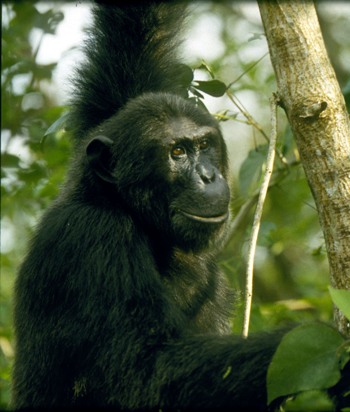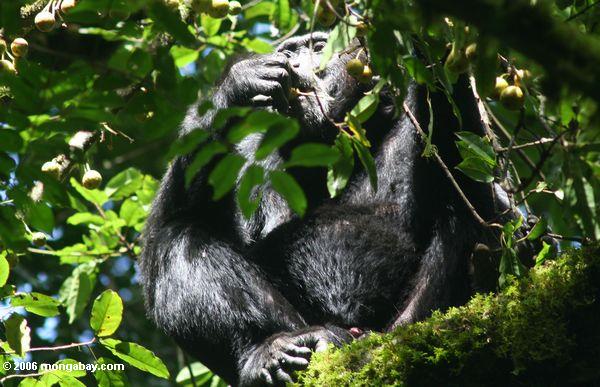Humankind’s closest relative, the chimpanzee, is classified as Endangered by the IUCN Red List. Threatened by habitat and forest loss, hunting for bushmeat, trafficking for the illegal pet trade, mining, and disease, the species remains in a precarious position. Yet a new 10-year-plan with East and Central African hopes to ensure the chimpanzee’s (Pan troglodytes) survival.
The plan, which focuses on one subspecies of four, the eastern chimpanzee (Pan troglodytes schweinfurthii), pushes for the conservation of 16 core areas that would protect 96 percent of the eastern chimpanzee population.
Outlined during a workshop last summer in Uganda, which included over 30 experts covering the seven nations where the eastern chimpanzee is located, the program estimated population both in well-studied and un-surveyed areas. Estimations of eastern chimpanzee population ranged from 50,000 to 200,000 animals.
 The eastern chimpanzee. Photo by: Andrew Plumptre/Wildlife Conservation Society. |
“It is clear that we know about the distribution and abundance of only a quarter of the world population of the eastern chimpanzee,” admitted Dr Liz Williamson, IUCN’s Species Survival Commission Great Ape Coordinator, in a press release.
Despite the species popularity and the fact that some chimp communities are well-studied, Williams says that “there are large areas of the Congo basin where we know very little about this ape.” The experts hope over the next decade to fill-in the gaps in their knowledge.
“This effort to assess the status of eastern chimpanzees will help us to focus our conservation actions more effectively,” explains Dr. Andrew Plumptre, the plan’s lead author and director of the Wildlife Conservation Society’s (WCS) Albertine Rift Program. “In the next decade, we hope to minimize the threats to these populations and the ecological and cultural diversity they support.”
Besides protecting 16 core areas of chimpanzee habitat, the plan also outlined goals to reduce poaching and trafficking of the eastern chimpanzee by half over the next ten years. In addition the plan made goals to reduce the rate of deforestation in chimpanzee habitat; better understand the threat of diseases to the chimpanzees; involve local communities in conservation efforts; and locate sustainable funding sources.
Dr. James Deutsch of WCS’s Africa Program estimated that 5 million US dollars will be needed annually to support viable chimpanzee conservation units.
“The conservation of wild populations is important not only for conservation, but also for the survival of chimpanzee cultures in the region that are invaluable to helping us define our own place within the natural realm,” Deutsch says.
Wild eastern chimpanzee in Uganda feeding on fruit. Photo by: Rhett A. Butler.
Related articles
Protected areas vital for saving elephants, chimps, and gorillas in the Congo
(05/10/2010) In a landscape-wide study in the Congo, the Wildlife Conservation Society (WCS) found that core protected areas and strong anti-poaching efforts are necessary to maintain viable populations of forest elephants, western lowland gorillas, and chimpanzees—all of which are threatened with extinction.

(04/12/2010) 2010 marks a monumental milestone for the Jane Goodall Institute (JGI) and its founder, Dr. Jane Goodall, DBE. Fifty years ago, Goodall, who is today a world-renowned global conservation leader, first set foot on the shores of Lake Tanganyika, in what is now Tanzania’s Gombe National Park. The chimpanzee behavioral research she pioneered at Gombe has produced a wealth of scientific discovery, and her vision has expanded into a global mission ‘to empower people to make a difference for all living things.’ Time, however, has not stood still for Gombe. The wild chimps of the area have suffered as the local human population has swelled. Gombe National Park is now a forest fragment, a 35-square-kilometer island of habitat isolated in a sea of subsistence farming. Because the problems facing Gombe—unsustainable land practices, overpopulation, and a cycle of poverty—are typical of many other areas, lessons learned by Dr. Goodall and her team provide valuable insights for solutions at Gombe and beyond.
Chimpanzee population plummets 90 percent in supposedly strong region
(05/06/2009) Chimp populations continue to decline in Africa. A new survey of our closest relatives in the Cote D’Ivoire found that the population fell from an estimated 8,000 to 12,000 individuals to a paltry 800 to 1,200, a decline that took place in less than twenty years.
